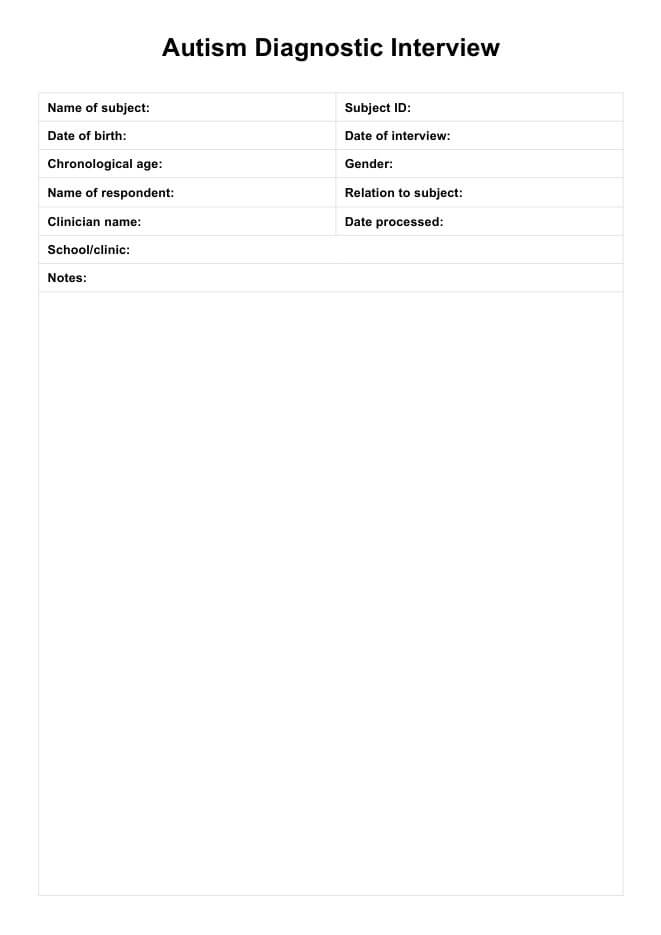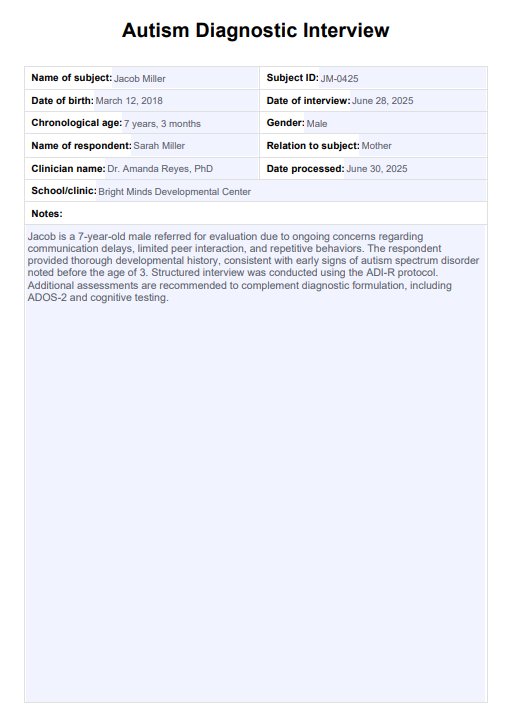Autism Diagnosis Interview (ADI)
Explore the benefits and use of the Autism Diagnosis Interview-Revised (ADI-R) for accurate autism assessment and management.


What is the Autism Diagnosis Interview-Revised (ADI-R)?
The Autism Diagnostic Interview-Revised (ADI-R) is a structured clinical interview used to diagnose autism in children and adults. Conducted by a trained clinician, the ADI-R focuses on three main areas: language and communication, reciprocal social interactions, and restricted, repetitive, and stereotyped behaviors and interests. The interview is primarily conducted with caregivers and thoroughly assesses the individual’s developmental history and current behavior.
The ADI-R is widely recognized as a comprehensive tool that helps differentiate autism from other developmental disorders. It is particularly useful in research settings to ensure consistent diagnostic criteria and is also used in clinical practice to guide treatment and educational planning. The detailed interview can take several hours to complete, requiring specific training for the interviewers to ensure the reliability and accuracy of the results.
How is it scored?
The ADI-R scoring system is based on a coded algorithm that evaluates responses across three main domains: qualitative abnormalities in reciprocal social interactions, communication and language, and restricted, repetitive, and stereotyped behavior patterns.
Each item is scored on a scale ranging from 0 to 3, where 0 indicates typical behavior and higher scores denote more significant deviations from typical development.
The scores are then compared to empirically established cutoffs to distinguish autism from other developmental disorders. A high score in each of the three domains is indicative of a diagnosis of autism spectrum disorder (ASD).
Next steps after using the ADI-R
After completing the ADI-R, the following steps are typically taken to proceed with care and further evaluations:
Step 1: Review the results
A trained clinician reviews the scores and determines whether they meet the diagnostic criteria for ASD based on the cutoffs provided by the ADI-R. This review also includes considering any previous assessments and current behavioral observations.
Step 2: Communicate the findings
The clinician discusses the results with the caregivers and, if appropriate, with the individual assessed. This conversation covers the diagnostic findings and the implications for the individual’s care and support needs.
Step 3: Plan further assessments
Further assessments may be necessary depending on the results and the individual’s age and specific symptoms. These can include medical evaluations, psychological assessments, or speech and language therapy assessments to understand the individual's needs comprehensively.
Step 4: Develop a treatment plan
Based on the comprehensive assessments, a personalized treatment plan is developed. This plan may include behavioral interventions, educational recommendations, therapy sessions, and possibly medication management.
Step 5: Implement support strategies
Implement the treatment and support strategies, engaging educational and therapeutic professionals as necessary. This step often involves ongoing collaboration between multiple professionals and the individual's family to ensure that the support provided meets the individual's evolving needs.
Step 6: Schedule follow-up assessments
Regular follow-up assessments are scheduled to monitor the individual’s progress and adapt the treatment plan as needed. These assessments are crucial for responding to changes in the individual's condition or needs over time.
Autism Diagnosis Interview (ADI) Template
Autism Diagnosis Interview (ADI) Sample
How to use our Autism Diagnosis Interview-Revised template
Carepatron has created a supplementary ADI-R template to help you document additional notes during your patient's assessment. Here's how to use the template:
Step 1: Download the resource
Get a copy of the Autism Diagnosis Interview-Revised template using the link on this page. It's also available in our resources librarby.
Step 2: Print or use the digital format
You can choose to print out the template or use it in its digital format. We recommend using a tablet or laptop for ease of typing and organization.
Step 3: Use during asseessments
Use the space provided in the template to jot additional notes or observations during your patient's ADI-R assessment. This will help you keep track of important details and refer back to them when needed.
Step 4: Save and store
Save the completed template in a secure location, either digitally or as a hard copy. This documentation can serve as a useful reference for future assessments or clinical discussions.
Benefits of using the ADI-R
The ADI-R offers several significant benefits for diagnosing ASD:
- Comprehensive assessment: The ADI-R provides a detailed, qualitative analysis of an individual's behavior across three crucial domains: social interaction, communication, and repetitive behaviors. This thoroughness helps in making a comprehensive evaluation of ASD symptoms.
- Standardization: As a standardized tool, the ADI-R ensures consistency in the diagnostic process across different practitioners and settings, contributing to the reliability and validity of the diagnosis.
- Diagnostic accuracy: The detailed nature of the ADI-R, combined with established scoring systems and thresholds, enhances the accuracy of autism diagnosis, distinguishing ASD from other developmental disorders.
- Guided intervention planning: The results can inform targeted intervention strategies by identifying specific challenges and strengths in the individual’s behavior, facilitating more personalized and effective treatment plans.
- Research utility: The ADI-R is widely used in research to ensure consistent diagnostic criteria, making it invaluable for studies on autism, its causes, and potential treatments. This contributes to a better understanding of the spectrum and advances in the field.
Commonly asked questions
The ADI-R aims to provide a comprehensive assessment tool for diagnosing autism in individuals by collecting detailed information on their developmental history and current behavior through structured interviews with caregivers.
The ADI-R typically takes between 1.5 to 2.5 hours to administer, depending on the complexity of the individual's behaviors and the thoroughness of the caregiver's responses.
The ADI-R consists of approximately 93 questions covering various aspects of behavior and development related to autism spectrum disorders.
There are a variety of diagnostic tools that can be used to assess autism in individuals. These can include behavioral assessments, such as the Autism Diagnostic Observation Schedule (ADOS) and the Childhood Autism Rating Scale (CARS), which involve observing and scoring specific behaviors related to autism.




